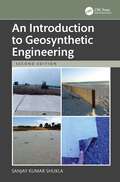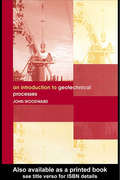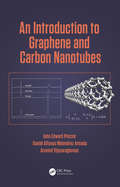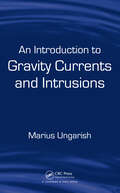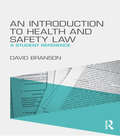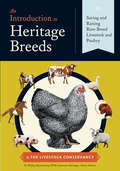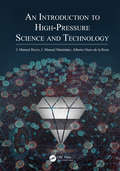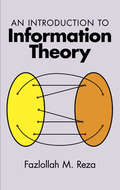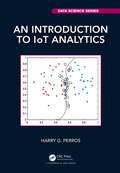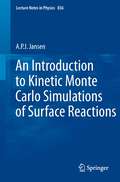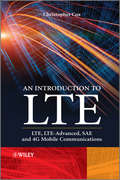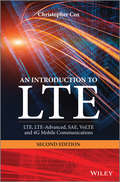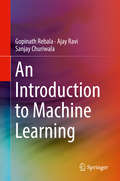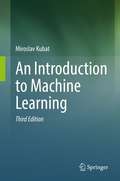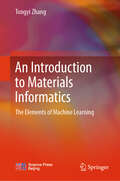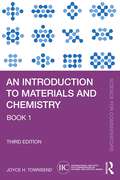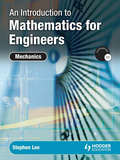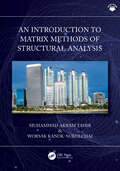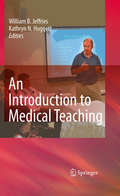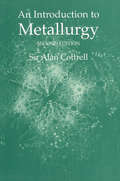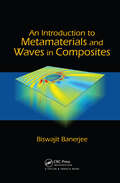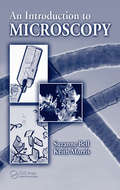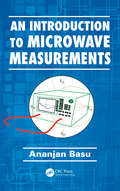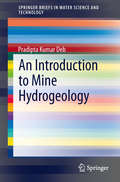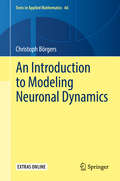- Table View
- List View
An Introduction to Geosynthetic Engineering
by Sanjay Kumar ShuklaGeosynthetics, primarily made from synthetic polymers, provide efficient, cost-effective, and sustainable solutions for civil, geotechnical, and environmental challenges. Enhancing infrastructure performance with soil and rock, they are integral to global construction standards. Beyond civil engineering, their applications extend to mining, agriculture, and aquaculture. This book explores the principles, properties, and applications of geosynthetics, offering tailored solutions for innovative and sustainable infrastructure development.This updated second edition of An Introduction to Geosynthetic Engineering provides a comprehensive introduction to geosynthetics, meeting the needs of senior undergraduate and postgraduate students, practising engineers, and professionals. It includes expanded content, updated chapters, new sections, detailed site photographs, revised standards and guidelines, additional examples, and practice questions. Tailored to support both learning and practical application, this textbook is an essential resource for understanding and utilizing geosynthetics in sustainable infrastructure development.
An Introduction to Geotechnical Processes
by John WoodwardThe study of the solid part of the earth on which structures are built is an essential part of the training of a civil engineer. Geotechnical processes such as drilling, pumping and injection techniques enhance the viability of many construction processes by improving ground conditions.Highlighting the ground investigation necessary for the process
An Introduction to Graphene and Carbon Nanotubes
by John E. Proctor Daniel Melendrez Armada Aravind Vijayaraghavan<p>Carbon nanotubes and graphene have been the subject of intense scientific research since their relatively recent discoveries. This book introduces the reader to the science behind these rapidly developing fields, and covers both the fundamentals and latest advances. Uniquely, this book covers the topics in a pedagogical manner suitable for undergraduate students. The book also uses the simple systems of nanotubes and graphene as models to teach concepts such as molecular orbital theory, tight binding theory and the Laue treatment of diffraction. <p>Suitable for undergraduate students with a working knowledge of basic quantum mechanics, and for postgraduate researchers commencing their studies into the field, this book will equip the reader to critically evaluate the physical properties and potential for applications of graphene and carbon nanotubes.</p>
An Introduction to Gravity Currents and Intrusions
by Marius UngarishGravity currents and intrusions are the ubiquitous phenomena where a fluid of one density flows horizontally into a fluid of a different density. For researchers and engineers, the ability to understand and predict these flow fields is essential in wide-ranging applications including those involved with atmospheric and ocean dynamics, the propagati
An Introduction to Health and Safety Law: A Student Reference
by David BransonAn Introduction to Health and Safety Law provides a clear, concise overview of health and safety law in the United Kingdom. With reference to the European Union, this book discusses criminal and civil liability at length to provide a clear understanding of this area of law which has been subject to change over the 20 years. Key case studies and statistical information on prosecutions, fines and enforcement notices help to contextualise health and safety law to provide students and professionals with a full understanding of health and safety law in the UK. This book includes chapters on: the legal framework criminal liability enforcement of criminal liability civil liability civil remedy subordinate legislation. This book is an essential reference for students studying towards NEBOSH qualifications and students studying at university level. It provides a comprehensive understanding of UK health and safety law and will be a useful reference when entering the professional field.
An Introduction to Heritage Breeds: Saving and Raising Rare-Breed Livestock and Poultry
by Alison Martin D. Phillip Sponenberg DVM Jeannette BerangerDeveloped for the particular needs of the working farm, heritage breeds have proved invaluable to small-scale agricultural production for centuries. This comprehensive guide explains why conserving heritage breeds remains important and how they often can be a better choice for the modern farmer than conventional animals. With profiles of heritage poultry, sheep, cattle, and more, you’ll learn how to select and successfully raise the breed that is right for your specific needs. Enjoy the benefits of resilient livestock while preserving genetic diversity for future generations.
An Introduction to High-Pressure Science and Technology
by Alberto Otero de la Roza J. Manuel Recio J. Manuel MenéndezAn Introduction to High-Pressure Science and Technology provides you with an understanding of the connections between the different areas involved in the multidisciplinary science of high pressure. The book reflects the deep interdisciplinary nature of the field and its close relationship with industrial applications.Thirty-nine specialists in high
An Introduction to Information Theory (Dover Books on Mathematics)
by Fazlollah M. RezaWritten for an engineering audience, this book has a threefold purpose: (1) to present elements of modern probability theory — discrete, continuous, and stochastic; (2) to present elements of information theory with emphasis on its basic roots in probability theory; and (3) to present elements of coding theory.The emphasis throughout the book is on such basic concepts as sets, the probability measure associated with sets, sample space, random variables, information measure, and capacity. These concepts proceed from set theory to probability theory and then to information and coding theories. No formal prerequisites are required other than the usual undergraduate mathematics included in an engineering or science program. However, since these programs may not include a course in probability, the author presents an introductory treatment of probability for those who wish to pursue the general study of statistical theory of communications. The book is divided into four parts: memoryless discrete themes, memoryless continuum, schemes with memory, and an outline of some recent developments. An appendix contains notes to help familiarize the reader with the literature in the field, while the inclusion of many reference tables and an extensive bibliography with some 200 entries makes this an excellent resource for any student in the field.
An Introduction to IoT Analytics (Chapman & Hall/CRC Data Science Series)
by Harry G. PerrosThis book covers techniques that can be used to analyze data from IoT sensors and addresses questions regarding the performance of an IoT system. It strikes a balance between practice and theory so one can learn how to apply these tools in practice with a good understanding of their inner workings. This is an introductory book for readers who have no familiarity with these techniques. The techniques presented in An Introduction to IoT Analytics come from the areas of machine learning, statistics, and operations research. Machine learning techniques are described that can be used to analyze IoT data generated from sensors for clustering, classification, and regression. The statistical techniques described can be used to carry out regression and forecasting of IoT sensor data and dimensionality reduction of data sets. Operations research is concerned with the performance of an IoT system by constructing a model of the system under study and then carrying out a what-if analysis. The book also describes simulation techniques. Key Features IoT analytics is not just machine learning but also involves other tools, such as forecasting and simulation techniques. Many diagrams and examples are given throughout the book to fully explain the material presented. Each chapter concludes with a project designed to help readers better understand the techniques described. The material in this book has been class tested over several semesters. Practice exercises are included with solutions provided online at www.routledge.com/9780367686314 Harry G. Perros is a Professor of Computer Science at North Carolina State University, an Alumni Distinguished Graduate Professor, and an IEEE Fellow. He has published extensively in the area of performance modeling of computer and communication systems.
An Introduction to Kinetic Monte Carlo Simulations of Surface Reactions (Lecture Notes in Physics #856)
by A.P.J. JansenKinetic Monte Carlo (kMC) simulations still represent a quite new area of research, with a rapidly growing number of publications. Broadly speaking, kMC can be applied to any system describable as a set of minima of a potential-energy surface, the evolution of which will then be regarded as hops from one minimum to a neighboring one. The hops in kMC are modeled as stochastic processes and the algorithms use random numbers to determine at which times the hops occur and to which neighboring minimum they go. Sometimes this approach is also called dynamic MC or Stochastic Simulation Algorithm, in particular when it is applied to solving macroscopic rate equations. This book has two objectives. First, it is a primer on the kMC method (predominantly using the lattice-gas model) and thus much of the book will also be useful for applications other than to surface reactions. Second, it is intended to teach the reader what can be learned from kMC simulations of surface reaction kinetics. With these goals in mind, the present text is conceived as a self-contained introduction for students and non-specialist researchers alike who are interested in entering the field and learning about the topic from scratch.
An Introduction to LTE: LTE, LTE-Advanced, SAE and 4G Mobile Communications
by Christopher CoxAn Introduction to LTE explains the technology used by 3GPP Long Term Evolution. The book covers the whole of LTE, both the techniques used for radio communication between the base station and the mobile phone, and the techniques used for signalling communication and data transport in the evolved packet core. It avoids unnecessary detail, focussing instead on conveying a sound understanding of the entire system. The book is aimed at mobile telecommunication professionals, who want to understand what LTE is and how it works. It is invaluable for engineers who are working on LTE, notably those who are transferring from other technologies such as UMTS and cdma2000, those who are experts in one part of LTE but who want to understand the system as a whole, and those who are new to mobile telecommunications altogether. It is also relevant to those working in non technical roles, such as project managers, marketing executives and intellectual property consultants. On completing the book, the reader will have a clear understanding of LTE, and will be able to tackle the more specialised books and the 3GPP specifications with confidence. Key features - Covers the latest developments in release 10 of the 3GPP specifications, including the new capabilities of LTE-Advanced Includes references to individual sections of the 3GPP specifications, to help readers understand the principles of each topic before going to the specifications for more detailed information Requires no previous knowledge of mobile telecommunications, or of the mathematical techniques that LTE uses for radio transmission and reception
An Introduction to LTE: LTE, LTE-Advanced, SAE, VoLTE and 4G Mobile Communications
by Christopher CoxFollowing on from the successful first edition (March 2012), this book gives a clear explanation of what LTE does and how it works. The content is expressed at a systems level, offering readers the opportunity to grasp the key factors that make LTE the hot topic amongst vendors and operators across the globe. The book assumes no more than a basic knowledge of mobile telecommunication systems, and the reader is not expected to have any previous knowledge of the complex mathematical operations that underpin LTE. This second edition introduces new material for the current state of the industry, such as the new features of LTE in Releases 11 and 12, notably coordinated multipoint transmission and proximity services; the main short- and long-term solutions for LTE voice calls, namely circuit switched fallback and the IP multimedia subsystem; and the evolution and current state of the LTE market. It also extends some of the material from the first edition, such as inter-operation with other technologies such as GSM, UMTS, wireless local area networks and cdma2000; additional features of LTE Advanced, notably heterogeneous networks and traffic offloading; data transport in the evolved packet core; coverage and capacity estimation for LTE; and a more rigorous treatment of modulation, demodulation and OFDMA. The author breaks down the system into logical blocks, by initially introducing the architecture of LTE, explaining thetechniques used for radio transmission and reception and the overall operation of the system, and concluding with more specialized topics such as LTE voice calls and the later releases of the specifications. This methodical approach enables readers to move on to tackle the specifications and the more advanced texts with confidence.
An Introduction to Machine Learning
by Sanjay Churiwala Gopinath Rebala Ajay RaviJust like electricity, Machine Learning will revolutionize our life in many ways – some of which are not even conceivable today. This book provides a thorough conceptual understanding of Machine Learning techniques and algorithms. Many of the mathematical concepts are explained in an intuitive manner. The book starts with an overview of machine learning and the underlying Mathematical and Statistical concepts before moving onto machine learning topics. It gradually builds up the depth, covering many of the present day machine learning algorithms, ending in Deep Learning and Reinforcement Learning algorithms. The book also covers some of the popular Machine Learning applications. The material in this book is agnostic to any specific programming language or hardware so that readers can try these concepts on whichever platforms they are already familiar with. Offers a comprehensive introduction to Machine Learning, while not assuming any prior knowledge of the topic;Provides a complete overview of available techniques and algorithms in conceptual terms, covering various application domains of machine learning;Not tied to any specific software language or hardware implementation.
An Introduction to Machine Learning
by Miroslav KubatThis textbook offers a comprehensive introduction to Machine Learning techniques and algorithms. This Third Edition covers newer approaches that have become highly topical, including deep learning, and auto-encoding, introductory information about temporal learning and hidden Markov models, and a much more detailed treatment of reinforcement learning. The book is written in an easy-to-understand manner with many examples and pictures, and with a lot of practical advice and discussions of simple applications. The main topics include Bayesian classifiers, nearest-neighbor classifiers, linear and polynomial classifiers, decision trees, rule-induction programs, artificial neural networks, support vector machines, boosting algorithms, unsupervised learning (including Kohonen networks and auto-encoding), deep learning, reinforcement learning, temporal learning (including long short-term memory), hidden Markov models, and the genetic algorithm. Special attention is devoted to performance evaluation, statistical assessment, and to many practical issues ranging from feature selection and feature construction to bias, context, multi-label domains, and the problem of imbalanced classes.
An Introduction to Materials Informatics: The Elements of Machine Learning
by Tongyi ZhangThis textbook educates current and future materials workers, engineers, and researchers on Materials Informatics. Volume I serves as an introduction, merging AI, ML, materials science, and engineering. It covers essential topics and algorithms in 11 chapters, including Linear Regression, Neural Networks, and more. Suitable for diverse fields like materials science, physics, and chemistry, it enables quick and easy learning of Materials Informatics for readers without prior AI and ML knowledge.
An Introduction to Materials and Chemistry: Book 1 (Science for Conservators)
by Joyce H. TownsendThis new edition of An Introduction to Materials and Chemistry, book 1 in the updated Science for Conservators series, provides conservators and conservators-in-training with a very basic introduction to the language of chemistry and to the scientific approach. Drawing on 40 years of experience as a conservation scientist, Joyce H. Townsend takes readers through the elementary steps that will enable them to understand and investigate materials in historic objects, and those modern materials used to conserve them, in scientific terms. The book also introduces basic chemistry concepts. It provides worked examples and exercises throughout. This new edition has been significantly expanded and updated, with new material about health and safety, sustainability, and the trend to use greener materials, amongst other topics. The book also includes all-new illustrations, a list of further reading and is accompanied by a Companion Website, which features additional examples, illustrations and more. An Introduction to Materials and Chemistry assumes no previous scientific knowledge and will be essential reading for pre-program applicants to, and students already on, postgraduate conservation programs worldwide. It will also be useful to conservators who are looking to refresh their knowledge or to fill gaps in their training, and for those who trained in languages other than English, but now work in that language.
An Introduction to Mathematics for Engineers: Mechanics
by Stephen LeeThis new introductory mechanics textbook is written for engineering students within further and higher education who are looking to bridge the gap between A-Level and university or college.
An Introduction to Matrix Methods of Structural Analysis
by Muhammad Akram Tahir Worsak Kanok-NukulchaiThe matrix force method has been systematically developed for the analysis of beam and frame structures. It helps develop the matrix stiffness method from a basic spring element, and this is extended to the analysis of beams, trusses, plain frames, grillages, and space frames.Using computer programs (manual, automatic, or the direct force method extending toward automation), this book interactively introduces matrix methods of structural analysis. In addition to work and energy, it also discusses the concepts of stresses, strains, strain displacement relationship, and plain stress and strain. Features: Explains force, displacement, and stiffness via the matrix perspective. Reviews full programming code for each problem. Provides the modern concepts of force method that leads toward automation of the force method, such as the direct stiffness method. Discusses effect of temperatures exclusively. Includes the macro language Matrix Analysis Interpretive Language (MAIL) as an extension of analysis interpretive treatise with examples, exercises, PowerPoint slides, and illustrative problems. The MAIL executable, guide, and codes are provided on the website of the book. This book is aimed at senior undergraduate and postgraduate students in structural engineering.
An Introduction to Medical Teaching
by William B. Jeffries Kathryn HuggettFew faculty members in academic medical centres are formally prepared for their roles as teachers. This work is an introductory text designed to provide medical teachers with the core concepts of effective teaching practice and information about innovations for curriculum design, delivery, and assessment. It offers brief, focused chapters with content that is easily assimilated by the reader. Topics are relevant to basic science and clinical teachers, and the work does not presume readers possess prerequisite knowledge of education theory or instructional design. The authors emphasize application of concepts to teaching practice. Topics include: Helping Students Learn; Teaching Large Groups; Teaching in Small Groups; Problem Based Learning; Team-Based Learning, Teaching Clinical Skills; Teaching with Simulation; Teaching with Practicals and Labs; Teaching with Technological Tools; Designing a Course; Assessing Student Performance; Documenting the Trajectory of your Teaching and Teaching as Scholarship. Chapters were written by leaders in medical education and research who draw upon extensive professional experience and the literature on best practices in education. Although designed for teachers, the work reflects a learner-centred perspective and emphasizes outcomes for student learning. The book is accessible and visually interesting, and the work contains information that is current, but not time-sensitive. The work includes recommendations for additional reading and an appendix with resources for medical education.
An Introduction to Metallurgy, Second Edition
by Sir Alan CottrellThis classic textbook has been reprinted by The Institute of Materials to provide undergraduates with a broad overview of metallurgy from atomic theory, thermodynamics, reaction kinetics and crystal physics, to elasticity and plasticity.
An Introduction to Metamaterials and Waves in Composites
by Biswajit BanerjeeRequiring no advanced knowledge of wave propagation, An Introduction to Metamaterials and Waves in Composites focuses on theoretical aspects of metamaterials, periodic composites, and layered composites. The book gives novices a platform from which they can start exploring the subject in more detail.After introducing concepts related to elasticity,
An Introduction to Microscopy
by Suzanne Bell Keith MorrisMicroscopy, which has served as a fundamental scientific technique for centuries, remains an invaluable tool in chemistry, biology, healthcare, and forensics. Increasingly, it is being integrated into modern chemical instrumentation and is of value as a powerful analytical tool across many scientific disciplines. Designed to serve as a primary reso
An Introduction to Microwave Measurements
by Ananjan BasuGo Beyond Basic Distributed Circuit AnalysisAn Introduction to Microwave Measurements has been written in a way that is different from many textbooks. As an instructor teaching a master's-level course on microwave measurements, the author recognized that few of today's graduate electrical engineering students are knowledgeable about microwave measu
An Introduction to Mine Hydrogeology (SpringerBriefs in Water Science and Technology)
by Pradipta Kumar DebAn Introduction to Mine Hydrogeology briefly describes the subject of hydrogeology so that this knowledge can be integrated into mine development planning. It emphasizes not only the hydrochemical but also the physical impacts of the hydrogeological environment on the mine and its surroundings. Further, it discusses the methodologies used in mine hydrogeological studies, showcased by selected studies on Indian mines.
An Introduction to Modeling Neuronal Dynamics
by Christoph BörgersThis book is intended as a text for a one-semester course on Mathematical and Computational Neuroscience for upper-level undergraduate and beginning graduate students of mathematics, the natural sciences, engineering, or computer science. An undergraduate introduction to differential equations is more than enough mathematical background. Only a slim, high school-level background in physics is assumed, and none in biology. Topics include models of individual nerve cells and their dynamics, models of networks of neurons coupled by synapses and gap junctions, origins and functions of population rhythms in neuronal networks, and models of synaptic plasticity.An extensive online collection of Matlab programs generating the figures accompanies the book.
